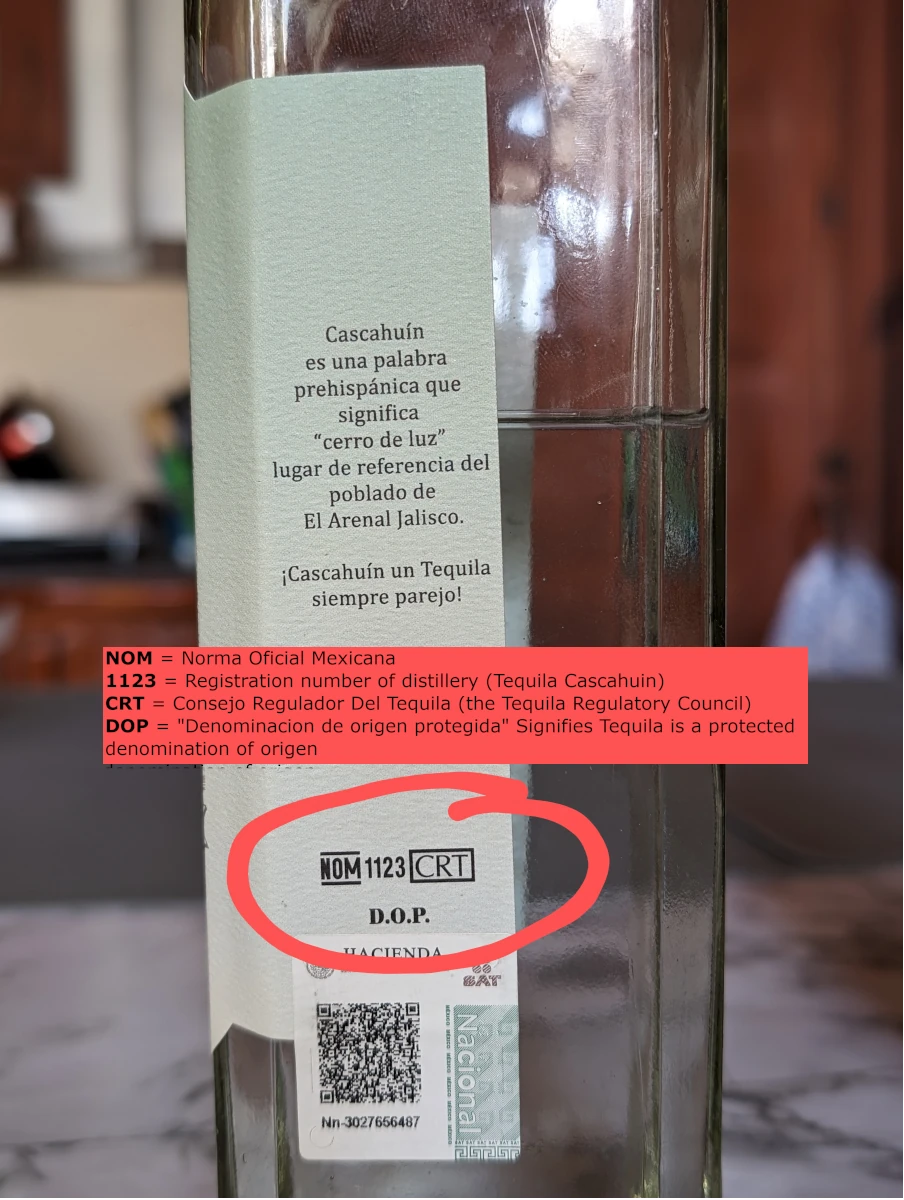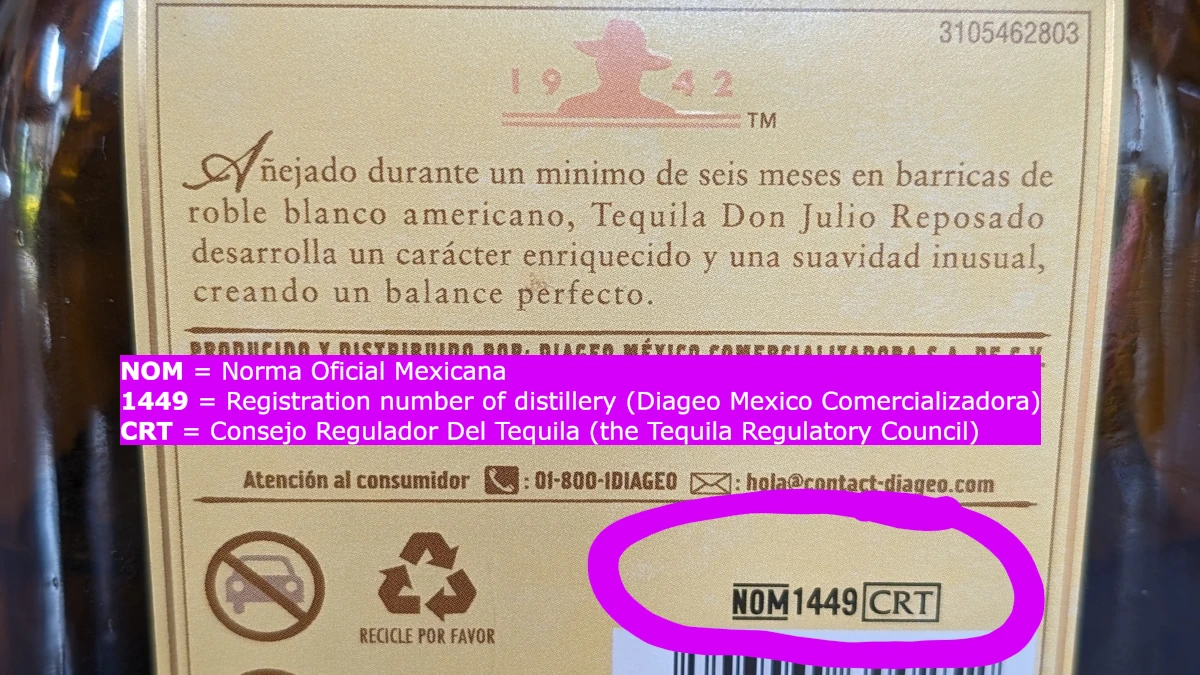A tequila NOM number is the four digit registration number which relates to the individual authorized tequila producer. The NOM number corresponds to the registered distillery for producing that tequila. A NOM number is printed on every authentic bottle of tequila.
NOM is the Norma Oficial Mexicana, which are official standards issued by the government and related bodies that cover a range of goods and services in Mexico including tequila and mezcal.
Quick Facts About NOMs
- Each bottle of tequila has a four digit NOM which identifies the authorized producer who bottled that tequila.
- Bottlers can technically buy tequila from other certified producers, so it’s not a guarantee that the tequila was actually made at that NOM.
- There are 170 NOMs for tequila that produce over 2,000 different brands of tequila. Most brands use third party manufacturing.
- A handful of NOMs make just one brand, but most make many. The NOM with the most brands makes over 200.
- In some cases tequilas from the same NOM taste similar but this is not at all a rule, there are many variables that can create widely different tasting tequilas from the same NOM.
- The NOM for tequila is one of many NOMs (Norma Oficial Mexicana) that set out rules and regulations for many goods and processes in Mexico.
Table of Contents
Behind NOMs
NOMs in Mexico
NOMs in Mexico are official government standards that cover a diverse range of products and industries, not just tequila. Other industries covered include telecommunications equipment, consumer goods and automotive products. Processed food and beverages, including mezcal, are also covered by their own NOMs.
Official Mexican Standard (NOM), is a mandatory technical regulation issued by the competent standardization agencies through National Standardization Committees, in accordance with Article 40 of the Federal Metrology and Standardization Law (LFMN), which establishes the rules, specifications, attributes, guidelines, characteristics or requirements applicable to a product, process, service or production method or operation, as well as the rules regarding terminology, symbology, packaging and marking or labeling and their compliance or application
https://www.gob.mx/se/acciones-y-programas/standards
NOM for Tequila
The NOM governing tequila is NOM-006-SCFI-2012. This NOM sets out the characteristics and specifications to be met by those involved in tequila production under tequilas denomination of origen, or appellation of origin. This includes the methods of production and the requirement to obtain certification.
The CRT is the regulator of tequila in Mexico (Consejo Regulador del Tequila) and is the certification body for the NOM for tequila.
One of the tequila NOM requirements is for the authorized producer registration number to be displayed on every bottle of tequila. This number is known as the NOM number, and corresponds to the authorised distillery where the tequila was bottled. All tequila with the same NOM number are bottled at the same distillery.
There is kind of loophole because as long as both distilleries are registered, distillery A can buy tequila from distillery B and sell it under its own label. Either blended with its own product or on its own.

How to Lookup a Tequila NOM Number?
If you have a bottle of tequila, you can check the label for the NOM number. If you have the brand, or the NOM number and want to check the distillery the most up to date way to check the list of NOMs is to go to the CRT website. This is frequently updated with the full list of NOMs and registered tequila brands.
A Brand’s NOM Can Change Over Time
Most brands do not own their production facilities, they use distilleries owned by third parties. Most major brands do own their distilleries as it makes more financial sense. It is fairly common for brands to move production facilities and hence change NOMs over time. This happens when fast growing brands outgrow their facilities, when large tequila companies acquire a new brand and move it into existing facilities, or when smaller brands look to change producers based on better offers.
Brands the have changed NOMs include:
- Casamigos: from NOM 1416 to NOM 1609
- Kirkland Signature: Currently NOM 1142 (silver/blanco) and NOM 1173 (reposado and añejo) but previously NOM 1472 and NOM 1438
- Pasote: from NOM 1579 to NOM 1584
- Pura Vida: from NOM 1534 to NOM 1558
You can also go to Tequila Matchmaker which maintains its own list of NOMs and brands, as well as the historical NOMs where a brand may have changed NOM. This may not be as up to date but should be pretty close. For example Costco’s Kirkland Signiture Tequila brands have changed NOMs over the years and you can see this on Tequila Matchmaker.
How Many NOMs are There?
There are 170 NOMs registered for production of tequila as of January 2024 according to the CRT. These 170 NOMs produce over 2,000 different brands. There are 2,169 registered brands of tequila as of January 2024.
This number overstates how many actual brands of tequila there are. Some of the registered brands are variations on the one brand, for example there are seven brands registered to NOM 1120 (Tequila Siete Leguas) that would all be considered under the same Siete Leguas brand:
- Siete Leguas
- 7 Leguas
- Siete Leguas 7 Leguas
- 7 Leguas Siete Decadas
- De Antaño Siete Leguas
- D’ Antaño
- Antaño
Some NOMs produce just one brand of tequila (for example, Patrón and Teremana). Others produce dozens. The NOM with the most brands is NOM 1438 (Casa Maestri, at Destiladora del Valle de Tequila) which produces 279 brands of tequila as of January 2024.
NOMs for Top Brands of Tequila
NOM’s for the top selling brands of tequila:
- Jose Cuervo is made at NOM 1122 (the same as 1800 and Gran Centenario)
- Patrón is made at NOM 1492
- Don Julio is made at NOM 1449
- Casamigos is made at NOM 1609
- 1800 tequila is made at NOM 1122 (the same as Jose Cuervo and Gran Centenario)
- Hornitos is made at NOM 1102 (the same as Sauza)
- Gran Centenario is made at NOM 1122 (the same as Jose Cuervo and 1800)
- El Jimador is made at NOM 1119
- El Espolòn is made at NOM 1440
- Olmeca and Olmeca Altos are made at NOM 1111
- Cazadores is made at NOM 1487
- Sauza is made at NOM 1102 (the same as Hornitos)
- Lunazul is made at NOM 1513
- Teremana is made at NOM 1613

Do All Tequilas Have a NOM?
Yes, all certified tequilas have a NOM printed on the bottle. Non-certified tequilas firstly shouldn’t have “tequila” on the bottle and may be called something like “liquor de agave” or “destilado de agave” or similar. Non-certified agave spirts are more common with mezcal.
There are of course counterfeit spirits being sold as tequila which may have a made up NOM printed on the bottle. You can check the list of NOMs from the CRT to see if a brand is listed under the NOM.
Do all Tequilas From the Same NOM Taste the Same?
No, just because tequilas are made at the same location, they can still taste very different due to different ingredients and production methods and “recipes”. Tequilas from the same NOM are more likely to taste similar, but this is no guarantee. As described above, tequila sold under one NOM may have actually been produced by another NOM.
The more brands a distillery produces the more likely there will be variation in production style and quality. Tequilas from the same NOM or distillery can vary widely due to:
- Difference in agave used
- The NOM number covers the distillery itself, not where the agave comes from
- Difference in methods for cooking
- Some distilleries have diffusors, brick ovens and autoclaves to covert carbohydrates into fermentable sugars. You cannot tell which method was used by the NOM number alone. For example, Jose Cuervo’s NOM1122 has all of this equipment.
- Difference in extraction method
- The common extraction methods are by using a diffusor, a roller mill or tahona (large stone). Distilleries can use just one, or a combination of these methods to crush the agave piñas. For example, Patron (NOM 1492) uses both tahona and roller mill in its base line of tequila. It’s Roca line (now discontinued but still available in some places) used just tahona.
- Difference in fermentation
- The same distillery can use wild yeast or commercial yeast; use stainless steel tanks and wooden tanks; ferment with fibers and without fibres.
- Difference in aging
- There are a wide range of possible variations when it comes to aging, beyond just the number of months: American or French oak; first fill or reused; barrel char level; ex-bourbon or ex-sherry or ex-wine etc.
- Use of additives
- Tequila producers often used undisclosed additives in their product to change the taste, texture and color of the finished product.
What are the Best NOMs?
The highest rated NOMs tend to focus on just one or a few brands. According the most popular user rated source, Tequila Matchmaker, the NOMs with the highest ratings are:
| Rank | NOM | Distillery | Brands |
|---|---|---|---|
| 1 | NOM 1493 | Tequila Los Abuelos | 2 Brands (same tequila): Los Abuelos (for outside US), Fortaleza (in the US) |
| 2 | NOM 1579 | El Pandillo | 7 Brands e.g.: Terralta, Volans, ArteNOM Selección de 1579, G4 |
| 3 | NOM 1123 | Tequila Cascahuin | 19 Brands, e.g.: Cascahuín, Siembra Valles, Wild Common |
| 4 | NOM 1474 | Tequilera Los Alambiques | 4 Brands: Ocho, Muestra No. Ocho, Los Alambiques, Curado |
| 5 | NOM 1120 | Tequila Siete Leguas | 7 Brands (All versions of the Siete Leguas brand) |
